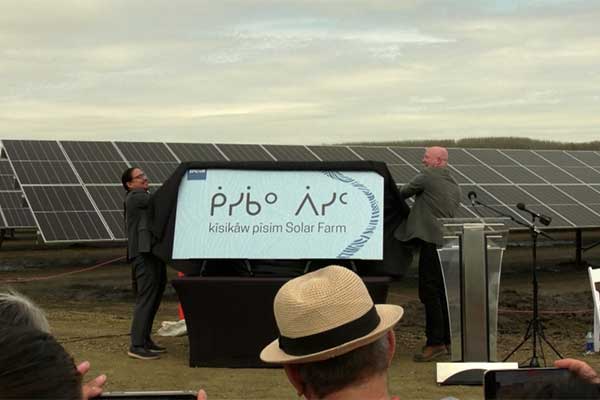- Located in the Edmonton southwest river valley, Epcor’s controversial solar farm spans 51 acres with 30,000 panels and is set to open in September.
- The project was initially opposed by wildlife groups and the Cree Nation. A hearing took place, and a memorandum of understanding was signed.
- Epcor took steps to reduce the environmental impact of the solar farm. During a traditional Indigenous naming ceremony, the Enoch Cree Nation named the new solar farm, kisikaw pisim.
Epcor’s new solar farm, kisikaw pisim, is located in Edmonton’s river valley; it spans 51 acres and utilizes 30,000 solar panels.
Set to open in September, the solar farm will generate enough renewable energy to power half of Epcor’s water treatment plant.
Initially, many wildlife groups and members of the Cree Nation openly opposed the controversial project, even bringing the issue to court. Deciding to invite the Cree Nation to name the solar farm through a traditional Indigenous ceremony was a step in the right direction, helping to bridge the gap to reconciliation.
In the beginning, the Cree Nation was openly opposed to the kisikaw pisim solar farm, which would be constructed on Enoch Cree Nation territory. Wilderness groups also expressed worries about the solar farm’s impact on wildlife in the area.
Concerns were raised about the loss of habitat for various species of animals as well as the impact the solar farm could have on birds. Birds can sometimes confuse solar panels for water and land on them too roughly, injuring themselves.
Since the hearing, Epcor has taken measures to greatly reduce its environmental impact. Epcor decreased its ecological footprint by 18% and expanded the wildlife corridor by 25% with trees and shrubs. The company also transferred 31.5 acres from their water treatment plant to the city, for Edmonton to designate into conservation areas and trails.
Enoch Cree Nation Chief Billy Morin did not support the solar farm at first but after a memorandum of understanding was signed with Epcor, for the company to respect and honour history, Chief Morin is now fully on board with the project. The memorandum signifies the beginning of an ongoing partnership with the Cree Nation; it includes a commitment from Epcor to honour the history and respect the land, while potentially expanding their water treatment plant in the future.
It was Epcor who suggested consulting the Cree Nation and inviting them to perform the traditional naming ceremony, a decision Chief Morin was receptive to and appreciated. He is now able to drive through the community and point out Cree names to his young children, names that Edmontonians are now learning to say. It’s a big shift, for the Indigenous youth who experienced a loss of language to now see it proudly displayed on Edmonton city signs.
A traditional Indigenous naming ceremony took place in January to give the solar farm its name, kisikaw pisim, which means daylight sun.
Chief Morin spoke on the significance of the sun in Cree culture, describing how members of his community give thanks to the sun every morning, feeling grateful to bear witness to another sunrise. EPCOR president and CEO Stuart Lee, commented on the traditional naming ceremony being unlike any other method for choosing a name he had experienced, finding it powerful and moving.
The opening for kisikaw pisim solar farm was delayed by a few months due to supply chain issues but it is currently set to open in September, optimistically in time for the equinox.
The decision to name the solar farm through a traditional Indigenous naming ceremony was a meaningful step in the right direction, a step that could help bridge the gap towards reconciliation. Observers of the ceremony walked away with newfound knowledge and appreciation for Cree culture.
It’s a noteworthy action, which may inspire other corporations to follow suit.













Comments